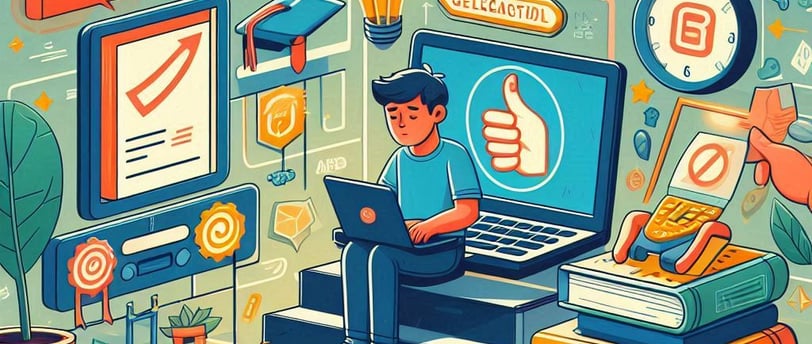Self-Regulation Goals for Students: A Path to Academic Success
Self-regulation is not just a skill for academic success—it is a lifelong ability that prepares students for future challenges. By setting clear goals, managing time wisely, and staying motivated, students can develop habits that will serve them beyond school into their careers. With the support of teachers, parents, and the right strategies, self-regulation can become a powerful tool for any student aiming to achieve their highest potential.
SELF-HELP
kanav pareek
3/24/20256 min read


Self-regulation is one of the most powerful tools students can develop to achieve academic and personal success. It goes beyond simple goal-setting; it is about managing emotions, thoughts, and behaviors to stay on track. In a world filled with distractions, self-regulation equips students with the discipline and strategies necessary to focus on their studies, manage time effectively, and stay motivated.
A well-regulated student does not just react to academic demands but proactively plans, adjusts, and refines their learning strategies. Whether it’s managing exam stress, sticking to study schedules, or overcoming procrastination, self-regulation is the backbone of self-directed learning.
This article will explore the concept of self-regulation goals, their importance, and how students can implement them to improve their academic performance and overall well-being.
Understanding Self-Regulation in Education
Self-regulation in education refers to the ability of students to manage their learning processes through cognitive control, emotional regulation, and behavioral management. It involves setting goals, monitoring progress, and adjusting behaviors to reach academic success.
Psychologists define self-regulation as the ability to:
Set and pursue learning objectives
Maintain focus and avoid distractions
Manage emotions effectively in stressful academic situations
Reflect on performance and make improvements
For students, self-regulation means having the awareness and strategies to control their study habits, manage time wisely, and develop a proactive approach to learning rather than reacting passively to assignments and exams.
The Science Behind Self-Regulation
Several psychological theories explain the process of self-regulation:
Zimmerman’s Self-Regulated Learning Theory
Proposes that self-regulation occurs in three phases: forethought (planning), performance (monitoring), and self-reflection (evaluation).
Bandura’s Social Cognitive Theory
Suggests that self-regulation is influenced by personal, behavioral, and environmental factors, emphasizing the role of self-efficacy in achieving goals.
Research shows that students who practice self-regulation are more likely to succeed academically because they take responsibility for their learning, adapt to challenges, and persist despite setbacks.
Key Components of Self-Regulation
For self-regulation to be effective, students must develop the following core skills:
1. Goal Setting
Setting clear, realistic, and achievable goals helps students stay focused and motivated.
2. Self-Monitoring
Students must regularly assess their progress, identify what is working, and adjust their strategies accordingly.
3. Self-Reflection
Reflecting on what worked and what didn’t enables students to improve their learning techniques over time.
Setting Effective Self-Regulation Goals
Students must set structured and meaningful goals to guide their academic journey. One effective way to do this is by using the SMART Goals Framework:
Specific – Clearly define what needs to be achieved
Measurable – Set criteria for tracking progress
Achievable – Ensure the goal is realistic
Relevant – Align the goal with broader academic objectives
Time-bound – Set a deadline for completion
For instance, instead of saying, “I want to study more,” a SMART goal would be: “I will study for two hours daily for the next three weeks to prepare for my math exam.”
The Role of Motivation in Self-Regulation
Motivation plays a crucial role in sustaining self-regulation efforts. It can be categorized into:
Intrinsic Motivation: Learning for personal satisfaction and curiosity.
Extrinsic Motivation: Studying to achieve external rewards like grades or parental approval.
Students with intrinsic motivation are more likely to maintain self-regulation habits in the long run because they enjoy the learning process rather than just focusing on outcomes.
Emotional Regulation for Academic Success
Emotions greatly influence learning. Stress, anxiety, and frustration can derail academic performance if not managed properly. Some effective strategies include:
Practicing mindfulness and deep breathing techniques
Breaking tasks into manageable parts to avoid feeling overwhelmed
Seeking support from teachers, parents, or counselors when facing challenges
Time Management and Self-Regulation
Time management is an essential part of self-regulation. To make the most of their study time, students should:
Prioritize tasks based on urgency and importance
Use planners or digital apps to schedule study sessions
Avoid multitasking, as it reduces efficiency
Implement the Pomodoro Technique (25-minute focused study sessions followed by short breaks)
By managing their time effectively, students can reduce last-minute stress and complete their assignments on schedule.


Developing Self-Discipline and Focus
Self-discipline is the foundation of self-regulation. Without it, students may struggle to stay consistent with their goals. Here are some effective ways to build discipline and maintain focus:
1. Create a Distraction-Free Study Environment
A cluttered and noisy environment can make studying difficult. Students should find a quiet space, minimize digital distractions, and use apps like Freedom or StayFocusd to block distracting websites.
2. Build Strong Study Habits
Habits shape behavior. Creating a daily study routine, setting aside dedicated study hours, and sticking to them can lead to long-term success.
3. Practice Mindfulness and Concentration Exercises
Practicing mindfulness through meditation or deep breathing can improve focus. The 5-4-3-2-1 grounding technique can help students regain concentration when their minds wander.
4. Use Positive Reinforcement
Rewarding progress, whether with a small break, a favorite snack, or a fun activity, can reinforce positive behaviors and motivate students to stay on track.
Technology and Self-Regulation in Learning
Technology can either support or hinder self-regulation. While digital tools provide excellent learning opportunities, they can also lead to procrastination.
Helpful Tools for Self-Regulation
Forest App – Encourages focused study time by growing virtual trees when students stay away from their phones.
Notion/Evernote – Helps organize notes and set academic goals.
Trello – Allows students to track assignments and deadlines visually.
Avoiding Digital Distractions
Using website blockers to prevent access to social media during study hours.
Keeping phones on silent mode or in another room.
Using guided study sessions with apps like Focus@Will for concentration-enhancing background music.
The Teacher’s Role in Enhancing Student Self-Regulation
Teachers play a crucial role in helping students develop self-regulation skills. They can:
Provide clear guidelines and expectations to help students set goals.
Offer constructive feedback to help students identify areas for improvement.
Encourage self-reflection exercises, such as journaling about learning experiences.
Foster a growth mindset, teaching students that intelligence and skills improve with effort.
Parental Support for Self-Regulation
Parents also influence a child's ability to self-regulate. They can support students by:
Creating a structured home environment with designated study areas.
Encouraging independence by letting children manage their schedules.
Teaching accountability, ensuring students take responsibility for their learning.
Providing emotional support when students feel overwhelmed with academic stress.
A balanced approach—offering guidance while allowing independence—helps children develop lifelong self-regulation skills.
Challenges in Achieving Self-Regulation Goals
Despite the benefits of self-regulation, students often face challenges such as:
1. Procrastination
Delaying tasks due to a lack of motivation or fear of failure. Solution: Break tasks into small steps and set deadlines.
2. Lack of Motivation
Losing interest in studies. Solution: Find personal meaning in learning and set rewarding goals.
3. Poor Time Management
Struggling to balance academics and extracurricular activities. Solution: Use planners and prioritize essential tasks first.
4. Emotional Stress
Feeling anxious or overwhelmed. Solution: Practice stress-relief techniques and seek support from teachers or counselors.
Case Studies and Real-Life Examples
Case Study 1: A Student Who Overcame Procrastination
John, a high school student, struggled with procrastination. After learning about self-regulation, he started using the Pomodoro Technique, set daily goals, and eliminated distractions. As a result, his grades improved, and he became more confident in his abilities.
Case Study 2: Self-Regulation in a College Student
Sarah, a college freshman, faced challenges managing her coursework. She began using digital planners and self-reflection journals to track her progress. Over time, she became more organized and performed better academically.
Conclusion and Future Implications
Self-regulation is not just a skill for academic success—it is a lifelong ability that prepares students for future challenges. By setting clear goals, managing time wisely, and staying motivated, students can develop habits that will serve them beyond school into their careers.
With the support of teachers, parents, and the right strategies, self-regulation can become a powerful tool for any student aiming to achieve their highest potential.
MORE CONTENT
1 Understanding Its Importance, Benefits, and Ways to Improve It
2 Best Growth Mindset Books to Transform Your Thinking and Achieve Success
3 No Social Media for a Month: How It Transformed My Life
(FAQs)
1. How can students improve self-regulation skills?
Students can improve self-regulation by setting SMART goals, monitoring progress, managing time effectively, and developing self-discipline through consistent study habits.
2. What are some common obstacles to self-regulation?
Procrastination, lack of motivation, poor time management, and emotional stress are common challenges students face when trying to self-regulate.
3. How can teachers help students develop self-regulation?
Teachers can guide students by setting clear expectations, offering feedback, and encouraging goal-setting and self-reflection activities.
4. Can technology help with self-regulation?
Yes, technology can be a useful tool for self-regulation. Apps like Notion, Trello, and Forest help students stay organized and focused. However, students must also limit digital distractions.
5. Why is self-regulation important for long-term success?
Self-regulation helps students develop essential life skills like discipline, time management, and resilience, which are crucial for personal and professional growth.
Blog
Content
Engage
contact@growthtimewithme.com
© 2024. All rights reserved.
